Victoria Barbour's Blog, page 4
December 15, 2014
Debut release for Xio Axelrod: The Calum
I'm thrilled to share the debut release of my friend Xio Axelrod's romance novel, The Calum. Below you'll find the blurb, and of course, all the wonderful places you can pick it up when it officially releases tomorrow (December 16). Congratulations Xio. I'm sure this is the first of many great books from you.
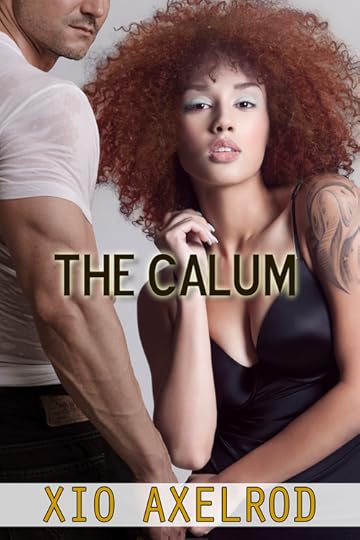
Twenty-six is too old to believe in fairytales, but tell that to Lovie’s roommate. Convinced she’ll find a real life version of her ultimate book boyfriend, Calum MacKenzie, Jo drags Lovie to the Scottish Highlands. Lovie’s no cynic *ahem* but she knows The Calum is a myth. A construct. A freaking unicorn! And there are warmer places to spend Christmas vacation.
If Duff had his way, he’d never step foot in Inverness again. Only his best friend’s wedding, and his ailing grandmother, could bring him home. Duff’s plan is keep his head down and stay out of trouble. Hard to do when the groom targets a pretty blond tourist for one last conquest.
When Duff and Lovie meet, stones, sparks and insults fly. He’s instantly attracted to the sexy, sharp-tongued American. She’s just glad to have someone to hang out with, especially the bad boy with a mysterious past. Lovie is determined to learn his secrets, but as they grow closer, Duff is forced to choose between his best friend and his heart.
About Xio
Philadelphia native and global citizen, Xio Axelrod writes love stories, sexy romance and what she likes to call “strange, twisted tales.” Bitten by the literary bug in 2003, she has self-published two volumes of poetry. Her short stories have also appeared in e-magazines such as Oysters and Chocolate. After a five year hiatus from writing, Xio returned with the fiery web serial, Starstruck: a story about finding the right person at the wrong time that became a viral hit. The Calum is book one in a series.
Xio is a vocalist and songwriter by day and lives in Philadelphia with her husband, Mr. X, and their on-again/off-again cat, BB.
Find out more about Xio here!
Pick up your copy of The Calum here (starting tomorrow morning!)December 10, 2014
Historical Wednesday: December 10, 2014

Another Wednesday, another fabulous post about the regency era. Thanks so much to my fellow Romance Writers Weekly pal Collette Cameron (author of fantastic regency romances!) for coming along today to share her knowledge with us. I'm so pleased with this post for many reasons, high amongst them Collette's use of images. On Facebook Collette spends a lot of time sharing the most beautiful images with her friends and it always brightens my day.
The Quill by Collette Cameron
Today I'm talking about Regency writing. No, not writing Regency romance, but actually writing with a quill. You know, a feather.
As an author, it's nearly impossible for me to imagine writing with a quill pen. I can barely write legibly with a fine point gel pen.
During the Regency Era, though metal nibs had been invented, they were rarely used. Quill pens were preferred and much more economical.
I had no idea that different sized quills were used for varies sized text. It makes sense. It's not like they had a computer they could change the font size with a simple click of a mouse.
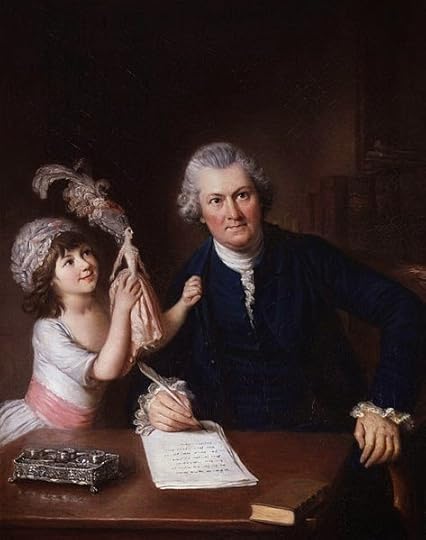
Goose feathers were a popular choice for quills. (I've had geese and turkeys and often wondered if their quills would have been used for writing. Both were.) The most desirable quills came from swans or peacocks. The tip of the quill (the nib) is trimmed with a knife before writing with the feather.
Why you ask? Well, how else were they to vary the thickness of the writing? I suppose this was done when one didn't have a smaller feather sitting about.

Feathers from crows, hawks, owls, pheasants, and eagles were also used. And lest you worry about the foul from whence said feathers were obtained, molted feathers were used. No chasing unsuspecting birds about the barnyard yanking feathers from them. Feathers were sorted into three grades, primes, seconds, and pinions, according to size of the quill.
The feathers had to be hardened too. This was done by dipping the tip of the feather into hot sand until the outer membrane pulled away. The softened quill was then flattened and the end rounded. Another method to harden the quill was to boil the ends for a minute, and then lay them out to dry. This process was repeated on the finer quality pen, those longest and largest, several times. Hardened quills were more flexible and less brittle.

Another interesting tidbit I discovered while researching Regency writing implements was that the word pen actually comes from the Latin word penna. Want to guess what it means? You're right: feather. I read contradicting accounts on whether left-handed people preferred feathers from the right wings and right-handed people preferred feathers from the left wing. Some sources said this was true, while others maintained it wasn't.
I also learned that the barb, the actually feathery part of the pen, was trimmed as the nib was shortened from use. Some people cut away the barb completely before they began to use the pen. Those pictures we see of the huge plumes on the ends of quill pens?
Nope. Didn't happen.
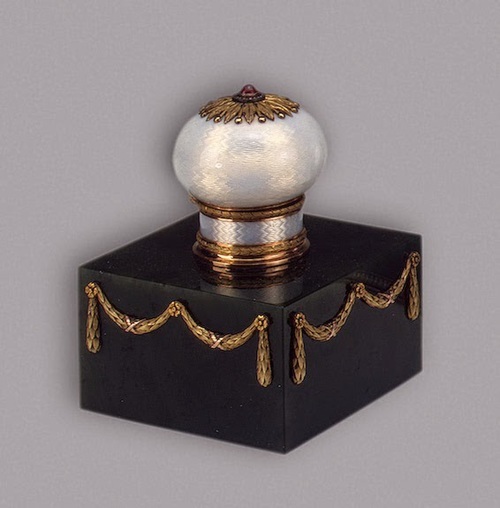
To write, the tip was dipped into an ink pot. The quill held a small amount of ink, so redipping every little bit was necessary. (I can just imagine the unholy mess I'd make.) A blotter was used to pick up excess ink. Then, the document was sprinkled with sand to speed up the drying process. If one needed to transport their quills, a metal quill case was often used.
I'm trying to picture Jane Austen writing away with her quill. Have you ever written with a quill pen? What was it like?
Award winning, Amazon best-selling, and multi-published historical author Collette Cameron was born and raised in a small town along the northern Oregon coast. To this day, the beach continues to remain one of her favorite retreats. If you've ever lived near the ocean, you understand the irresistible, captivating draw of the sea! An enthusiast of times gone by, Collette currently writes Regency and Scottish historical romances.
Learn more about her on her website.
Resources:
http://janeaustensworld.wordpress.com...
http://en.wikipedia.org/wiki/Quill
http://regencyredingote.wordpress.com...
http://medievalwriting.50megs.com/too...
All pictures courtesy of Wikimedia Commons
null
December 9, 2014
Romance Writers Weekly: December 9, 2014

"Tis the season to be jolly" and crank up the old Christmas tunes. What a fun topic this week. Many thanks to Xio Axelrod for making us try and choose our favourite Christmas song. This is very difficult for me, mainly because I can never pin down just one thing as a favourite, and what might be top of the list this morning could be forgotten by this evening.
Yes, I'm one of those people, where every second or third song that comes on the radio is "My favourite song in the whole wide world." What can I say? I like way more things than I dislike.
So here's what I'm going to do. I'll list my top three Christmas songs, and we can all assume that this fluctuating list will change many times between now and old Christmas day.
Now, without further adieu, here are some of my favs! (Videos included so you can sing along!)
The Cherry Tree Carol, by Jose FelicianoThis song makes me cry every time I hear it. And while there are plenty of beautiful versions, there's no other like this. His voice and the guitar, the sincerity of it all, crushes me. And I love it.
Oh Holy Night
Another classic carol that kicks me right in the heart strings. And still, it makes me smile as well. It brings back memories of a crisp winter night at the family cabin where my cousin and I belted this out at the top of our lungs. We thought we were the best singers ever! She's actually pretty great. Me, not so much. Anyhow, there are a lot of beautiful versions out there and I honestly have no particular favourite. But for today, let's say this version by Josh Groban is pretty awesome. I do prefer piano versions over huge orchestras, so this has a bit of both.
Barefoot Santa Claus by Sonny James
So when I was a kid, I loved this song. These days my favourite kid christmas song is the Hippopotamus one, but there's no way I can lie and say that this wasn't what got my little feet tapping at Christmas time. So here it is, in all its barefoot glory!
Honourable mentions go out today to other favs including:
Anything by Boney MCarol of the BellsThe Mummer's SongGrandma Got Run Over by a ReindeerSome Kenny & Dolly christmas songs
The Blarmling Dilemma (Hearts in Orbit Book 1)
By S.C. Mitchell
Now pop on over and say "Jingle Bells" to S.C. Mitchell to see what he has on his list. And be sure to check out his brand new release, The Blarmling Dilemma.
December 3, 2014
Historical Wednesday: December 3, 2014

Is it possible to be giddy with delight over a post? I don't know what I'm more excited about today. The content of Barbara Burke's blog post, or the style with which it's written. Either way, get ready for a delightful and insightful look into understanding the naming protocols of the English aristocracy. I can guarantee you I'll be referencing this as I continue on with my regency writing.
Your Grace, my Lord and plain old Mr: Recognizing Who’s Who in a library full of bodice rippers and Regencies by Barbara BurkeSir Walter Elliot, of Kellynch Hall, in Somersetshire, was a man who, for his own amusement, never took up any book but the Baronetage...So begins Jane Austin’s novel Persuasion.
To Sir Walter and, indeed, most people reading Persuasion in 1818 when it was first published, the information found in the Baronetage about Sir Walter and his family tells a lot about him, his family and the Elliots’ place in society.
However, a North American audience of nearly two hundred years later can excuse itself for finding the intricacies and convolutions of a by-gone British society more than a little difficult to sort out. It’s nothing to be ashamed of. The fact that there are numerous guide books to correct usage attests to the complexity of the subject. In fact, even the titles of the guide books are complicated, as witnessed by Debrett’s Correct Form: Social and Professional Etiquette, Precedence and Protocol: An Inclusive Guide to Everything From Drafting Wedding Invitations to Addressing An Archbishop. A quick glance through Debrett’s shows that there is a correct title for absolutely anyone in ‘society’, from the king to the child of a disclaimed peer (a lord who for one reason or another gives up his title), and clear rules and guidelines for their usage.
Though it isn’t really necessary for someone who enjoys a good Regency or Historical romance to have a complete grasp of these rules, it does make it rather more fun to have some understand of who’s who and why, particularly if it gives you an opportunity to shake your head and feel superior when you catch an author making a faux pas.
Though things have now altered slightly to the extent that even the British royal family is changing its definition of primogeniture so that three generations from now (i.e., in Prince George’s time) the eldest child of the monarch rather than the eldest son will inherit the throne, historically speaking it is a pretty universal truth that the whole social system is patriarchal and women derived their status from the men in their families. Therefore, any list of ranks and honours is based on the men holding them rather than the women of their families, no matter how important those women may be.

You'd find all manner of leaping lords and ladies in the assembly rooms of Almack's.
At its simplest and leaving out the royal family, British society is divided into two categories: the nobility (also known as the aristocracy and the peerage) and the gentry. The aristocracy consists of five ranks, starting with Dukes at the top and then descending in order through Marquesses (or sometimes, depending on the individual title, Marquises), Earls, Viscounts and Barons. Though they have different ranks as peers they share some common features: they are all titled, their titles are hereditary and they have a right to a seat in the House of Lords, the British Upper House of Parliament (although this last privilege has now been considerably abridged).
Their wives are, in the same descending order, Duchesses, Marchionesses, Countesses (there is no such thing as an Earless, mores the pity - I always picture some deaf old dear at Almack’s trying desperately to hear the latest on dits and scandals) Viscountesses and Ladies. Barons’ wives are not and never were called Baronesses. Baroness is one of the few titles that a woman can hold in her own right (this is the title that Margaret Thatcher was granted, for example) although it was seldom seen in England until recently. Any Baroness who turns up in a Regency had better either be foreign or, in some rare cases, Scottish. If she isn’t she’s probably in the wrong book.
Ranking beneath the aristocracy is the gentry, who generally consists of knights and everyone else who is accepted in polite society. Sir Walter falls into this category and is of the highest rank of the gentry. He is a baronet, which is a hereditary title. However, he is not a lord and he cannot claim a seat in the House of Lords. One step down from him are knights, who are still considered titled but do not pass the title down to their children. Finally there are the lowly Misters who, as gentlemen, may put esquire after their names when they write them but have no other title.
Those are the ranks of the British aristocracy and gentry and they are relatively simple to learn. However, after that things get a lot more complicated.
Armiger, the pseudonymous author of Titles; Being A Guide To The Right Use Of British Titles And Honours written in 1918 has this to say when talking about addressing or discussing members of the nobility and gentry:
Nobody “who knows” would talk about “The Marquess, or Marchioness, of Montgomeryshire.” They would be called “Lord, or Lady, Montgomeryshire.”
Still less would they be referred to as “The Marquess” or “The Marchioness.” There are occasions on which the full title would be used, but it should never be done in intimate speech. “The Marquess” or “The Earl” are so very often used by popular novelists, who love the Peerage better than they know its ways, that it may be difficult to believe that they are showing ignorance where they wish to show intimacy. It is only wrong, of course, in that it is never done by the people of title themselves, or by those who mix with them...Anyone who spoke habitually of “The Marquess of Montgomeryshire” or “The Countess of Malvern,” instead of saying “Lord Montgomeryshire” or “Lady Malvern”, would show plainly that he had small knowledge of the matters in which he is now being instructed, and would be put down as an outsider, just as much as if he were to speak of Lady John Smith as “Lady Smith”.
How’s that for English snobbery at its finest?
There is some compensation in the fact that his condemnation is so widespread. Obviously, there are a great many people in the world labouring under a burden of ignorance. So how does one talk to and about the British nobility?
There are some fairly simple guidelines. First of all, dukes and duchesses abide by their own rules which are, generally speaking, different from those laid down for the rest of the Peerage. For one thing, all Ducal titles are territorial. You can’t have a Duke without him being the Duke of Somewhere. For another, they are never referred to as My Lord or My Lady. They are called Your Grace in the second person and His or Her Grace in the third. In the most formal circumstances they are also called The Most Noble as in The Most Noble Duke of Devonshire. Finally, even in relatively informal cases, it is always made clear that one is talking about a Duke or a Duchess rather than some more common garden variety of peer. So one never says Lord Devonshire, for example, but Duke in the second person or The Duke in the third. Personally, however, I can’t help but feel that if I met the Duke of Devonshire sauntering through the park and simply said: “Hi, Duke!” I’d feel like my next move would be to throw a stick for him to fetch.
The next two ranks, Marquesses and Earls, have some rules that they share with Dukes but not with the two lowest orders of the peerage. One of these rules is that their eldest son is given what is called a courtesy title. If money begets money then titles beget titles. The British aristocracy has been around for a long time and most noble families have managed through the generations to accumulate more than one title. Presumably so that at least some of these excess titles do more than just lie around collecting dust and waiting for a really, really formal occasion to get brushed off and put on, a peer’s eldest son gets to use one of them. The only condition is that it must be of a lower order then that of his dad. So if someone was both the Duke of Smith and the Duke of Jones his son couldn’t use the title Duke of Jones. However, if he were also the Marquess of Brown, and that was his next highest rank, then his son would use that title. Thus in Georgette Heyer’s Devil’s Cub, Dominic, the son and heir of the Duke of Avon, bears the title Marquis of Vidal which is his father’s next highest rank. This carries on to the next generation so that if, somewhere between Devil’s Cub and the sequel An Infamous Army, Dominic and his wife have a son while the Duke is still alive then he gets the next most important title in the line.
There is one more condition. A courtesy title can only be given to the heir apparent, never the heir presumptive. The heir apparent is someone whose claim to the title can never be challenged. In just about every case that is the eldest son. An heir presumptive can lose that position at any time. For instance, to continue using the Duke of Avon as our example, in the precursor to Devil’s Cub, These Old Shades, which takes place before Dominic is born, the Duke of Avon’s heir is his brother Lord Rupert Alastair. Lord Rupert is the heir presumptive because he can be displaced at any time simply by Avon managing to sire a legitimate son. Therefore, he doesn’t get to use the courtesy title Marquis of Vidal. This is probably because once you’ve given someone a title it’s not very nice to ask to have it back because a more worthy candidate has just been born.
(In Scotland they do things a little differently. The heir to a title is called the Master and it doesn’t matter whether he’s the heir apparent or the heir presumptive. Consequently, younger brothers of a peer are called the Master until the peer has a legitimate son who then takes over (and keeps) the title.)
Notice that Rupert, the Duke of Avon’s brother, is called Lord Rupert. This is a courtesy title granted to the younger sons of Dukes and Marquesses. These kinds of courtesy titles are always attached to the bearer’s first name to distinguish them from ‘real’ lords who have an actual hereditary title. All daughters of earls as well as dukes and marquesses follow the same rule and are referred to as Lady. So before she became the Princess of Wales, Lady Diana Spenser was so called because she was the daughter of the Earl of Warwick.
Finally, younger sons of earls and all the children of viscounts and barons are simply ladies and gentlemen although their name is prefixed by the term ‘The Honourable’ when it is written.
As we have been informed by the ever so proper Armiger, any peer ranking below a duke is referred to as Lord followed by his title (not his last name). So we say Lord Vidal, even though his name is Dominic Alastair. In the second person the correct way to refer to that person is “My Lord” and “His Lordship” in the third person. So, unless the peer is a duke you can’t tell what rank he holds. The same is true for his wife, so we refer to her as Lady Vidal and call her “My Lady” or “Her Ladyship”.
Baronets and knights are called Sir followed by their first names informally and their first and last name formally. Their wives are called Lady followed by their last names (to distinguish them from the daughters of peers). Thus Sir John Brown would be married to Lady Brown and that is the only proper way to refer to her. If her name was given as Lady Mary Brown it would mean she was the daughter of a high ranking peer. And if she were referred to as Lady John Brown it would mean that her husband was Lord John Brown, the younger son of a duke or marquess. Their children have no titles at all.
There are probably a thousand other rules of address and nuances to polite society which are well beyond the scope of this blog, including titles reserved for members of the royal family. And then there’s the question of how to address grandchildren of peers and younger daughters of gentlemen, members of the military, members of the clergy, members of the military or clergy who are also peers, widows, widows with married sons, widows with unmarried sons, widows who remarry...
Hmm, maybe historical romance writers can be forgiven their occasional mistakes after all.
Barbara Burke’s parapetetic life means she’s lived everywhere from a suburban house in a small town to a funky apartment in a big city, and from an architecturally designed estate deep in the forest to a cedar shack on the edge of the ocean. Everywhere she’s gone she’s been accompanied by her husband, her animals and her books. For the last 15 years she’s worked as a freelance journalist and has won several awards. She was a fan of Jane Austen long before that lady was discovered by revisionists and zombie lovers and thinks Georgette Heyer was one of the great writers of the twentieth century. She lives by the philosophy that one should never turn down the opportunity to get on a plane no matter where it’s going, but deep down inside wishes she could travel everywhere by train.
You can find out more about Barbara here and follow her on Facebook as well.
https://www.facebook.com/pages/Barbara-Burke/162847103814669
null
December 2, 2014
Romance Writers Weekly: December 2, 2014

It's time for the Romance Writers Weekly Christmas Cookie Recipe exchange! If you've come via Collette Cameron, I'm not sure we can top her spritz cookies but I'll try.
Mmmmmm. Cookies. I love cookies no matter the time of year, but there's something about Christmas that just makes eating them so much more acceptable.
I'm blessed to have a husband that bakes all year round so there's never any shortage in our home. Last night in bed I said "What recipe of yours do you want me to post tomorrow?" Because let's face it, with a toddler, that's about as exciting as it gets in our bed these days.
Anyhow, after much deliberation I've decided to go with his brownie recipe. Two reasons: They were already made so I could take a photo this morning of the real thing, and also, they are so good that they don't even need icing or ice cream or anything to add to them. They are moist, chocolatey, and decadent all on their own. And simple to make. Or at least that's what I'm told. Because I cook. He bakes. It's a great house we have.

Don't judge. This was my breakfast this morning. I'll have a healthy lunch. I promise.
Decadent Fudge Brownies
Ingredients
1 1/2 cup of flour3/4 cup of rich dark cocoa (The better your cocoa, the better your brownies!)1/2 tsp baking powder1 cup of melted butter3/4 cup of vanilla sugar (Vanilla Sugar. Simple to make. Poke a couple of long vanilla beans in a tall glass, fill with sugar, cover and let sit for a week. Mmmmm.)3/4 cup of brown sugar2 eggsWhat to do
Preheat oven to 350°F Lightly butter and flour a 9 x 13” (23 x 33 cm) pan, shaking out excess flour. You could use cocoa instead of flour. This is a great alternative.Whisk flour, cocoa and baking powder in a mixing bowl. Set aside. In a separate mixing bowl, whisk remaining ingredients. Combine both mixes and pour into prepared pan. Bake for 25 minutesEat! You can eat them warm with ice cream (my dad's favourite), eat them right from the pan with nothing on top (my favourite) or sprinkle cocoa or icing sugar on them. You can also spruce them up with icing, but trust me, they are perfect just as they are!Now hop on over to see the most amazing lebkuchen recipe from Betty Bolte! This cookie is new to me but I guarantee we'll be giving it a go.
Oh! And be sure to pop over to our Facebook party today. We're giving away books all day long!

November 26, 2014
Historical Wednesday: November 26, 2014

Fasten your seat belts, historical aficionados. Today we're taking a trip to Asia, specifically to Korea! I don't know about you but I find so much of what we consume about history is related to Europe that it's always a breath of fresh air when we get to learn something about other places. My guest today is Deborah Nam-Krane, author of The New Pioneers series. Let's check out her post.
Korean History: It’s Not All The Korean War by Deborah Nam-KraneKoreans have been asserting their right to carve out their own identity for centuries. China, the big kid in their neck of the woods, wanted Korea to be a part of China, and for a couple of centuries they got their wish. But Koreans (like many other peoples) stubbornly clung to the idea of their independence, and by 300 A.D. they had pushed out their Chinese conquerors. (A Korean historian might tell you that this event was the deciding factor in the fall of the Han dynasty; a Chinese historian might tell you it was going to happen eventually anyway.)
Korea wasn’t Korea at that point; it was Three Kingdoms, Koguryo, Paekchae and Silla.
While they frequently fought among themselves, they all agreed on one thing: China wasn’t going to go away, and it would be foolish to pretend otherwise. All of them entered into formal diplomatic relations with China, and at no point in history is China’s cultural influence not evident: language, arts, religion and, perhaps most importantly, philosophy and politics are all influenced by China.
In fact, when in 1443 the court of King Sejong instituted Hangul, or the Korean alphabet, it was met with outrage by some of the yangban, or Korean aristocracy. Although the Chinese characters never did full justice to the Korean vocabulary and hangul was established to do just that, in the eyes of the yangban, only barbarians used an alphabet (or a language) other than Chinese, and after hundreds of years battling the Mongols, this was seen as a slap in the face. (The rest of the Korean population, however, happily adopted the easy-to-learn alphabet.)
Centuries later, when the Japanese conquered Korea (don’t let anyone tell you that Korea abnegated itself; they refused to sign their existence away, and the only reason the royal seal appeared on the documents the Japanese prepared was because the Japanese representative affixed it himself), Korean identity was even more threatened. It was not enough that Japan demanded that Korea be considered a part of Japan; by the time World War broke out, the Japanese were demanding that Koreans change their names to Japanese names and otherwise use the Japanese language. (To get an idea of what that means, imagine that every child in England would have to be given a French name- or a German one.) While the Chinese had always understood Korea’s strategic importance, the Japanese considered the Koreans genetically and culturally inferior. In their minds, they were doing the Koreans a favor by forcing them to adopt Japanese customs.
We’ll never know what course Korean culture might have taken had it not been for the occupation. As many have said, culture is not monolithic, and all are subject to outside influences. But in addition to being subjected to systematic destruction, the response to the Japanese occupation varied from collaboration to open resistance, and those who resisted sought safe haven in the Soviet Union, the United States and China, among other places. All of them had very different ideas about the most effective means of achieving their ends, and by the time the Japanese were defeated by the United States in 1945, those important questions hadn’t been answered.
Even worse, when the Americans arrived in Korea, many genuinely did not understand that Korea had been a very unwilling part of Japan. Worse, they took their advice about how to proceed from the Japanese administrators on their way out. Naturally, most of them recommended the people who had worked with them, never mind how resented they were by the rest of the population. In retrospect, it’s not surprising that the subsequent elections saw so little participation and were repudiated by many; because of the way the long-simmering tensions were or rather weren’t handled, it was only a matter of time before they exploded in a civil war. It was Korea’s poor luck that its conflict could be exploited in a proxy war between the United States, the Soviet Union and China.


Look at where Korea is located. Is it any wonder there were so many invasions?
There are now two Koreas, and they could not be more different. One has embraced capitalism, and the other is hanging onto a mirage of a communist dream. Ironically, in the early years after the civil war, it was Communist North Korea, who disdained aid as a sign of weakness, that did well at first and South Korea was seen as something of an international beggar. By the late 80s, however, that had flipped; not only was South Korea the site of the Summer Olympics of 1988, it was also home to industries that would become among the most successful international corporations in the world, including Hyundai, Samsung and LG. Most importantly of all, they had finally overthrown their military dictators, and today South Korea’s presidents are allowed only one five-year term, a nice change from the decades of power previous presidents enjoyed. Modern South Korea boasts one of the most educated and productive populations in the world. Sadly, the same cannot be said of North Korea, which has endured multiple famines and become dependent on international aid over the last two decades under the corrupt Kim “dynasty”.
The dream of many Koreans who lived through the Korean War is to see both parts of their country reunited after sixty years. However, as that generation dies off and people no longer remember a time when the country was unified, it’s not clear that this will be a goal that will be pursued in the future. For now, we can only imagine what the people of that unified country will look like. I like to think that they will be as hardy, stubborn, brave and resourceful as their ancestors were two thousand years ago when they fought off the Chinese. Here’s hoping that fighting for unity is as motivating as fighting for freedom.

Deborah Nam-Krane is a writer in Boston proper who has been writing novels since the age of thirteen. When she's not homeschooling her sons or making sure her daughters get their work done, she's writing, reviewing and editing.
The best way to keep in touch is to follow her blog Written By Deb and subscribe to her newsletter (only publishing announcements, never spam).
null
November 19, 2014
Historical Wednesday: November 19, 2014

I'm so happy this week to have my dear friend and fellow Newfoundlander romance author Kate Robbins on the blog. Kate writes awesome Scottish medieval historicals set in the 15th century around the reign of James 1. Today she's sharing some thoughts with you!
Putting the History into Historical Romance by Kate RobbinsIf you’re a fan of the genre, you know there are several sub-genres to historical romance including Viking, Victorian, Western, Ancient, Medieval, the currently popular Scottish, and the uber giant Regency.

Though these sub-genres all take on different settings and eras, they all have one thing in common—readers who crave them. Let me tell you, if you are a budding writer and think you might be able to fudge some Regency detail? Forget it. Readers know these points in history so well, there’s no way around it. And they will tell you if you’ve gotten something wrong, too—just ask Mel Gibson.

That’s not to criticize readers, mind you. I think it’s amazing that the romance genre has produced such avid and dedicated readers. I write historicals set in fifteenth century Scotland. And while it is not as popular as those set during the Jacobite Rebellion, the attention to detail is no less important. The thing I’ve learned is that readers appreciate the attention to historical accuracy.
Every author will step away from the history and let the fiction take over at a different point too, which makes this genre so fascinating. Two different authors can take the exact same setting and the exact same conflict and will produce two completely different stories. That’s the beauty of this genre. There’s a reader out there for every author—and we are so fortunate for that!
Happy reading everyone!
Kate Robbins is an Amazon Bestselling author. Her latest release from her Highland Chiefs series is Enemy of the Highlander to be released on November 21st, 2014.
You can find Kate online at the following
null
November 18, 2014
Romance Writers Weekly: November 18, 2014

Ah, holidays. My American friends are gearing up for Thanksgiving (we had that last month) and then next month, Christmas. And what's one of the best things about holidays? That's right—FOOD! This week we are sharing our favourite holiday recipe. I thought long and hard about how to approach this post. I could have posted some dishes that I like, but honestly, when I think holidays, only one thing come to mind. Jiggs Dinner.
What's that, you say. (If you're not from Newfoundland & Labrador, that is.). Well, this meal has plenty of names. Jiggs Dinner is one of the most common ones. It's also called boiled dinner, cooked dinner, and my favourite, Pork and Cabbage. (Some also call it corned beef and cabbage.) Around my family we just call it Sunday Dinner. Although I'll eat it any day of the week.
In terms of holidays, this is what you eat for all the big ones. Christmas, Thanksgiving, Easter, New Years, Paddy's Day. I kid. About Paddy's Day. Although it can be a great cure for a hangover.
I challenge you to walk through any small town in Newfoundland on a Sunday and not be tempted by the smell of this dinner wafting out the windows of just about every house.
My grandmother makes this every Sunday. She makes enough for at least 20 people. There have been times when we've had people eating in kitchen, the living room, and the porch. And don't get me started on the fights that can break out when there's not enough of one of the key ingredients to go around. I know I've done a fork duel with more than one cousin for the last bit of salt beef.
So here we go. My holiday recipe for Jiggs Dinner - the visual version.
[image error]
Salt beef. If you don't have this, don't bother cooking because it's not Jiggs Dinner without it. This is basically cured bits of beef (usually the fatty scraps) that when boiled, retains a beautiful deep pink colour. I highly recommend you check out this link for the Old Pork website just to hear "88 year old Nan" tell you about her bit of beef.
[image error]
Split Yellow Peas. You need this for the other critical dish, Pease Pudding. Don't bother inviting me if this isn't in the pot. :) Now, there's two main camps on serving this (plus countless other "true" methods). Some mash their cooked peas in butter (these are the people who need to try my Nan's pudding). And others, like me, are purists, and want our pease pudding in the nice round shape is comes out of the pot so we can slice it and fill our plates with mounds of it.



[image error]
So there you have it. Your basic ingredients. Now you can get all fancy and add other specialty puddings. Molasses raisiin pudding is a favourite, as is blueberry pudding. And my aunt loves onion pudding. But I don't know how to make any of those so if you wanna get adventurous, go google those recipes. :)
But Victoria, you're likely wondering. What do I do with all of these wonderful root vegetables that have fed hardy Newfoundlanders for eons? Ahhhh. my friends. So simple.
Cooking!It takes three hours to make Jiggs Dinner. Let's say you want to eat at 6 pm (because that's what I did yesterday!). Here's our handy timeline.
3 pm: Put a big boiler on the stove. Use the tallest, biggest pot you have. You're going to be putting a lot of food in here. Fill about half way with water. Start to boil. Cut up your salt beef, trimming off a lot of the fat. For the sake of this post, let's say you're having six people for dinner. So make sure there's enough for each person to have a nice choice cut. You are NOT GOING TO SALT YOUR WATER because there's enough salt in this to pickle your ribs. As for your split peas, grab a cloth pudding bag (if you don't have one, cut the corner off an old pillow case and use that), pour in the container of peas and tie your bag loosely. Not super loose, but not too tight. You want to give your peas a chance to expand, but still form a pudding. I'm not gonna lie. There's trial and error involved here. Here's what it should look like. Pop it into the pot and then go read a book.

4:30 pm: By now you'll have cut up cabbage up into nice big chunks. Toss it in the pot. If your water seems a little low, add some from a hot kettle. If you have cabbage lovers, you'll want a fairly big head.
5:15 pm: Add your turnip and carrots. Keep carrots whole unless they're massive, in which case, cut them in half width wise. Have your turnip in nice large chunks as well. One turnip should be good unless they're small. I always get a turnip about the size of a honeydew mellon. I tend to do one carrot per person unless I know I have some major carrot lovers coming.
5:30 pm: Add your potatoes. Two per person and an extra one or two for the pot.
6 pm: Take it all out. I put potatoes on a big platter, carrots on their own plate, cabbage goes in a strainer over a bowl so the water drips out, turnip goes into a bowl and you mash it with butter and pepper, salt beef gets it own plate (you might need to cut it smaller), and the pease pudding goes on another.
A NOTE ON MEAT!
I haven't mentioned meat. This meal is typically accompanied by a roast of some sort. Turkey, chicken, pork, moose, grouse, goose, whatever you like, fill your boots. Yesterday, I cooked for my parents. They brought a roast and gravy. We had moose. Mmmmmm. Delicious!

Thank you Mr. Moose for living so we could eat. I always feel bad thinking about where my meat comes from, but I do prefer knowing it lived in the wild and was doing its natural thing until his life ended.
Finally, pile all your food on your plate, slather it in gravy if you have some (and you like it) and enjoy. Make sure you go back for more!
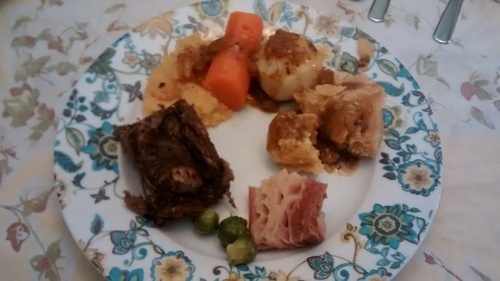
Confession time. When I cooked yesterday, I didn't have cabbage. Forgot to get it. And I forgot to get turnip greens, which are awesome. So I used brussel sprouts, which I hate. I put three teeny ones on my plate just to pretend so the wee one would eat his. Here's what's on the plate, clockwise: Carrots, potato, pease pudding, salt beef, yucky brussel sprouts, a huge piece of moose roast and mashed turnip. The hole in the centre of the plate is because when I was talking up dinner I was imaging piling my greens in there. So I left a space for respect. :)
Either you now want to try this, or you're wondering, why did I just spend this much time reading about a boiled dinner? Either way, head on over and see what delicious treat Raine Balkera has in store for you! And see you next week!
November 12, 2014
Historical Wednesday: November 12, 2014

Welcome to the second instalment of Historical Wednesdays. I'm thrilled to have one of my favourite Victoria's on the blog today, the lovely Ms. Victoria Danann., who just happens to be a USA Today Bestselling Author. Trust me when I say she rocks! You can find her bio and links at the end of her awesome post on the CW historical teen drama, Reign.
"Reign: Gossip girls in funky costumes" by Victoria DanannA long time ago, in a galaxy far far away named CW, there was a 16th century historical drama series with little resemblance to our reality. The show is supposed to center around the life and times of Mary, Queen of Scots.
Also called “Mary, Teen of Scots” by some, the show demonstrates everything that’s wrong with the ever-growing tendency to treat history as a rough draft. Perhaps it wouldn’t be so bad if the show began with disclaimers that names, dates, and places are fictional and any resemblance to actual events is purely coincidental.
The cynical among us would say that CW is a corporation tasked with a money making mission. Its purpose is to make money even if that means exploiting a target market populated by people whose brains are six years away from being fully developed. And who really cares if only one out of a hundred high school students could find France on a globe?
Regardless of intent, we are creatures who adapt and learn.
Here are a few things I learned from “Reign”. In 1557 they…
They danced the minuet to music played with electrical instruments that sounds very much like contemporary tweeny pop.When girls cried, mascara ran down their faces.They had no need of woodsmen because they used clean and convenient gas fireplaces.Queens did their own packing for traveling.They could ride in an open-windowed carriage in the middle of a snowy French winter, but noses don’t turn red, eyes didn’t water and magical thin capes, loosely tied over bare skin, were sufficient for warmth.Perhaps I pay too much attention to such details. Like dress for instance. In one of my former careers, I was an evening wear designer. As a child I was always especially interested in the awards for movie costume design and marveled at the amount of research and care that went into accurately reproducing costumes so that they were authentic, right down to using only fabrics that were available at the time. No Zippers. No buttons. Some even went so far as to make sure everything was hand sewn as they would have been at the time.
That tradition of faithfully recreating period dress may not be sacred, but CW has gone completely off the reservation. Take the ladies in waiting. Mary did have four, as was the custom for royalty. But they dressed like this…

Actual period dress for the time period.
NOT THIS!
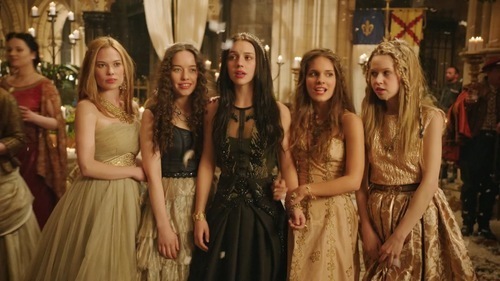
Prom, anyone?
If you think I’m done ragging on the costumer, you are so wrong.

Leather pants? Come on!
The push-up thing she’s wearing? Not a corset. Not a bustier. No. It’s a basque. It made its first appearance in fashion three hundred years after this period – minus the push-up feature.
The leather pants? Don’t get me started. Let me simply show what Henry’s clothes would have looked like.
[image error]
It may not be "in", but it's accurate!
Hate to Bash the show, but…
Sorry. Couldn’t resist. There was no Sebastian de Poitiers, bastard son of the king. He was invented for this photo and because the writers must have thought a love triangle would be cool.

If there had been a half-brother named Sebastien, I assure you he would not have been given a motorcycle club nickname like “Bash”. Had a fanciful name been bestowed, it would have sounded more like Sebastian Curt Hose or Sebastian the Sorrowful.
The fictional Bash does have striking blue eyes. I’ll give him that.
Regarding other casting choices, Mary – the real Mary - had bright auburn hair and hazel eyes. She was 5’11” which would probably compare today to a woman 6’5”. By contrast, Francis was abnormally short and so sickly that he was practically an invalid. He was married at fourteen and died at sixteen.

The actual Francis and Mary.
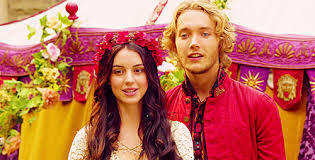
Francis and Mary on the show, but why quibble?
Next to the outrageous regard for historical accuracy in costuming, the thing that bothers me the most about this show is the deserted castle hallways and the deserted castle grounds. Love the shots of a lone couple, Mary and Francis, strolling the grounds of a castle built to house hundreds. Not one other person is present. Not the king’s guard or the queen’s guard (ancestors to the Secret Service which perhaps was somewhat secret seventy years ago when all men wore dark suits and white shirts). There’s not even a dog, cow, chicken or goat to be seen.
Look at it this way. If you’re a fan of Downton Abbey, you know how many staff is required to support a titled family of six living on an estate approximately five percent as large as that pictured in “Reign”.
During the time when the historical Mary was at French court, the hallways would have been perpetually busy with servants, guards, and guests of the king. The castle grounds would have been teeming with both people and industry that supported and served the needs of said noblemen.
But, really, who needs facts if a show works? Certainly not "Reign," – SFGATE
Don’t forget, we can’t have a hit teen show without a horror movie monster who lives in the woods and drinks human blood.
Still not enough to insure all buttons have been pushed? Let’s throw in some BDSM and menage a trois that results in the death of a young woman. Finally, a recipe for a hit teen TV show.
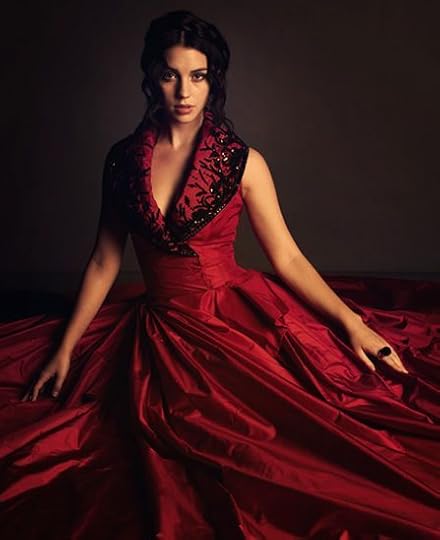
This dress would have scandalized a bordello of the time.
As a writer, I wonder what would happen if Mary had been cast as the rather plain looking individual that she was. Beautiful women get recognition for being beautiful and it comes with a certain measure of power, although short lived like bankable athleticism.
How much more interesting it would have been to portray Mary as being the center of a whirlwind of intrigue, love, sex, conspiracy, bad doings, and assassination plots – which was all true – and cast her just as she was, not beautiful.
I was excited about this show when I first saw the trailer. I thought it might interest a new generation in the study of history. I fell in love with English history because of the movie The Lion in Winter and went on to do graduate level studies because of it. I recall one conversation in particular among several graduate level students of history in which every one of us said movies had lit the spark. I hope such inspiration will always be available, but don’t look for it in “Reign”.
About Victoria Danann:
I write cross-genre with uniquely fresh perspectives on paranormal creatures, characters, and themes. Add a dash of scifi and a flourish of fantasy to enough humor to make you laugh out loud and enough steam to make you squirm in your chair. My heroines are independent femmes with flaws and minds of their own whether they are aliens, witches, demonologists, psychics, or past life therapists. My heroes are hot and hunky, but they also have brains, character, and good manners - usually - whether they be elves, demons, berserkers, werewolves, or vampires.
My first book, My Familiar Stranger, was nominated for Best Paranormal Romance of 2012 by both Reviewers' Choice and Readers' Choice Awards. All of my books have opened on the Amazon Best Sellers list and earned Night Owl Reviews TOP PICK awards.
For books published in 2013, Black Swan won three awards. 1. Best Paranormal Romance Series 2. Best Paranormal Romance Novel - A SUMMONER'S TALE 3. Best Vampire~Shifter Novel - MOONLIGHT.
If you're interested in me personally, I am also a classically trained musician who defected to Classic Rock music. I'm the utility player which means I play rhythm guitar, keyboards, sing back ups and a few leads. My band has covered everything (note for note) from Styx to Led Zepellin to Rush.
I live in The Woodlands, Texas which is why I sometimes joke about being the witch in the woods. Married. Four children. One very smart, mostly black German Shepherd dog.
WEBSITE/BLOG: www.VictoriaDanann.com
FACEBOOK FAN PAGE: www.facebook.com/vdanann
FACEBOOK AUTHOR PAGE: www.facebook.com/victoria.danann.9
GOODREADS FAN GROUP: https://www.goodreads.com/group/show/108735-victoria-danann-order-of-the-black-swan
TWITTER: @vdanann
PINTEREST: www.pinterest.com/vdanann
"Reign: Gossip girls in funky costumes" by Victoria Danann

Welcome to the second instalment of Historical Wednesdays. I'm thrilled to have one of my favourite Victoria's on the blog today, the lovely Ms. Victoria Danann., who just happens to be a USA Today Bestselling Author. Trust me when I say she rocks! You can find her bio and links at the end of her awesome post on the CW historical teen drama, Reign.
"Reign: Gossip girls in funky costumes" by Victoria DanannA long time ago, in a galaxy far far away named CW, there was a 16th century historical drama series with little resemblance to our reality. The show is supposed to center around the life and times of Mary, Queen of Scots.
Also called “Mary, Teen of Scots” by some, the show demonstrates everything that’s wrong with the ever-growing tendency to treat history as a rough draft. Perhaps it wouldn’t be so bad if the show began with disclaimers that names, dates, and places are fictional and any resemblance to actual events is purely coincidental.
The cynical among us would say that CW is a corporation tasked with a money making mission. Its purpose is to make money even if that means exploiting a target market populated by people whose brains are six years away from being fully developed. And who really cares if only one out of a hundred high school students could find France on a globe?
Regardless of intent, we are creatures who adapt and learn.
Here are a few things I learned from “Reign”. In 1557 they…
They danced the minuet to music played with electrical instruments that sounds very much like contemporary tweeny pop.When girls cried, mascara ran down their faces.They had no need of woodsmen because they used clean and convenient gas fireplaces.Queens did their own packing for traveling.They could ride in an open-windowed carriage in the middle of a snowy French winter, but noses don’t turn red, eyes didn’t water and magical thin capes, loosely tied over bare skin, were sufficient for warmth.Perhaps I pay too much attention to such details. Like dress for instance. In one of my former careers, I was an evening wear designer. As a child I was always especially interested in the awards for movie costume design and marveled at the amount of research and care that went into accurately reproducing costumes so that they were authentic, right down to using only fabrics that were available at the time. No Zippers. No buttons. Some even went so far as to make sure everything was hand sewn as they would have been at the time.
That tradition of faithfully recreating period dress may not be sacred, but CW has gone completely off the reservation. Take the ladies in waiting. Mary did have four, as was the custom for royalty. But they dressed like this…

Actual period dress for the time period.
NOT THIS!

Prom, anyone?
If you think I’m done ragging on the costumer, you are so wrong.

Leather pants? Come on!
The push-up thing she’s wearing? Not a corset. Not a bustier. No. It’s a basque. It made its first appearance in fashion three hundred years after this period – minus the push-up feature.
The leather pants? Don’t get me started. Let me simply show what Henry’s clothes would have looked like.
[image error]
It may not be "in", but it's accurate!
Hate to Bash the show, but…
Sorry. Couldn’t resist. There was no Sebastian de Poitiers, bastard son of the king. He was invented for this photo and because the writers must have thought a love triangle would be cool.

If there had been a half-brother named Sebastien, I assure you he would not have been given a motorcycle club nickname like “Bash”. Had a fanciful name been bestowed, it would have sounded more like Sebastian Curt Hose or Sebastian the Sorrowful.
The fictional Bash does have striking blue eyes. I’ll give him that.
Regarding other casting choices, Mary – the real Mary - had bright auburn hair and hazel eyes. She was 5’11” which would probably compare today to a woman 6’5”. By contrast, Francis was abnormally short and so sickly that he was practically an invalid. He was married at fourteen and died at sixteen.

The actual Francis and Mary.

Francis and Mary on the show, but why quibble?
Next to the outrageous regard for historical accuracy in costuming, the thing that bothers me the most about this show is the deserted castle hallways and the deserted castle grounds. Love the shots of a lone couple, Mary and Francis, strolling the grounds of a castle built to house hundreds. Not one other person is present. Not the king’s guard or the queen’s guard (ancestors to the Secret Service which perhaps was somewhat secret seventy years ago when all men wore dark suits and white shirts). There’s not even a dog, cow, chicken or goat to be seen.
Look at it this way. If you’re a fan of Downton Abbey, you know how many staff is required to support a titled family of six living on an estate approximately five percent as large as that pictured in “Reign”.
During the time when the historical Mary was at French court, the hallways would have been perpetually busy with servants, guards, and guests of the king. The castle grounds would have been teeming with both people and industry that supported and served the needs of said noblemen.
But, really, who needs facts if a show works? Certainly not "Reign," – SFGATE
Don’t forget, we can’t have a hit teen show without a horror movie monster who lives in the woods and drinks human blood.
Still not enough to insure all buttons have been pushed? Let’s throw in some BDSM and menage a trois that results in the death of a young woman. Finally, a recipe for a hit teen TV show.

This dress would have scandalized a bordello of the time.
As a writer, I wonder what would happen if Mary had been cast as the rather plain looking individual that she was. Beautiful women get recognition for being beautiful and it comes with a certain measure of power, although short lived like bankable athleticism.
How much more interesting it would have been to portray Mary as being the center of a whirlwind of intrigue, love, sex, conspiracy, bad doings, and assassination plots – which was all true – and cast her just as she was, not beautiful.
I was excited about this show when I first saw the trailer. I thought it might interest a new generation in the study of history. I fell in love with English history because of the movie The Lion in Winter and went on to do graduate level studies because of it. I recall one conversation in particular among several graduate level students of history in which every one of us said movies had lit the spark. I hope such inspiration will always be available, but don’t look for it in “Reign”.
About Victoria Danann:
I write cross-genre with uniquely fresh perspectives on paranormal creatures, characters, and themes. Add a dash of scifi and a flourish of fantasy to enough humor to make you laugh out loud and enough steam to make you squirm in your chair. My heroines are independent femmes with flaws and minds of their own whether they are aliens, witches, demonologists, psychics, or past life therapists. My heroes are hot and hunky, but they also have brains, character, and good manners - usually - whether they be elves, demons, berserkers, werewolves, or vampires.
My first book, My Familiar Stranger, was nominated for Best Paranormal Romance of 2012 by both Reviewers' Choice and Readers' Choice Awards. All of my books have opened on the Amazon Best Sellers list and earned Night Owl Reviews TOP PICK awards.
For books published in 2013, Black Swan won three awards. 1. Best Paranormal Romance Series 2. Best Paranormal Romance Novel - A SUMMONER'S TALE 3. Best Vampire~Shifter Novel - MOONLIGHT.
If you're interested in me personally, I am also a classically trained musician who defected to Classic Rock music. I'm the utility player which means I play rhythm guitar, keyboards, sing back ups and a few leads. My band has covered everything (note for note) from Styx to Led Zepellin to Rush.
I live in The Woodlands, Texas which is why I sometimes joke about being the witch in the woods. Married. Four children. One very smart, mostly black German Shepherd dog.
WEBSITE/BLOG: www.VictoriaDanann.com
FACEBOOK FAN PAGE: www.facebook.com/vdanann
FACEBOOK AUTHOR PAGE: www.facebook.com/victoria.danann.9
GOODREADS FAN GROUP: https://www.goodreads.com/group/show/108735-victoria-danann-order-of-the-black-swan
TWITTER: @vdanann
PINTEREST: www.pinterest.com/vdanann



